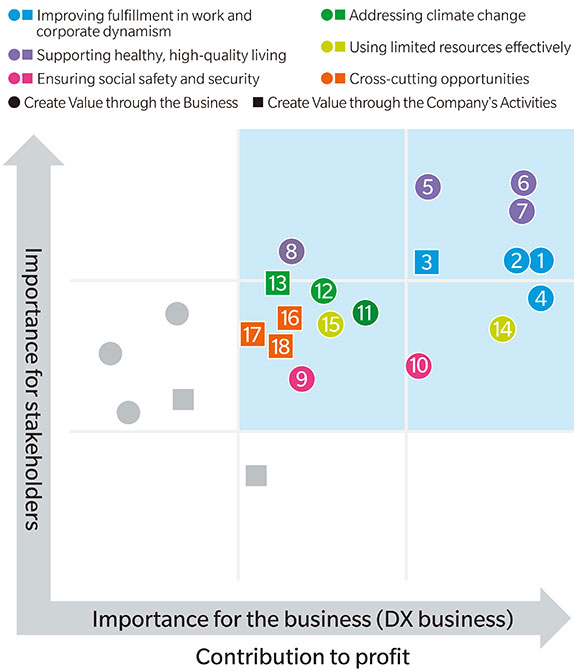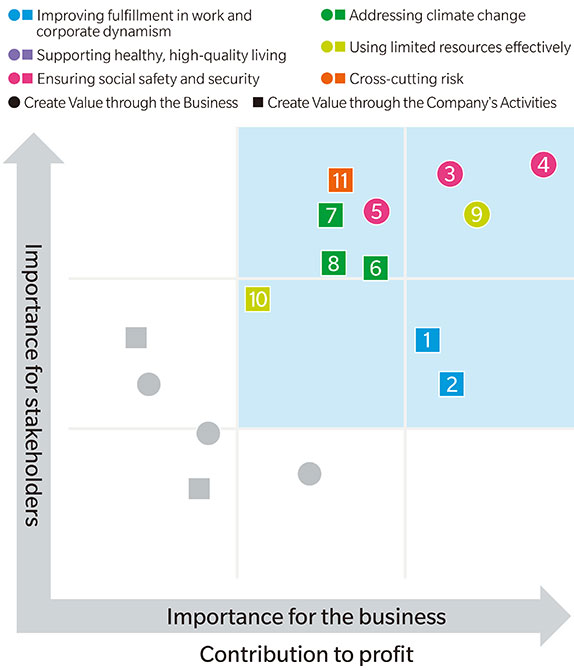Material Issue Evaluation and Identification Process
Evaluation and Identification Process
Step 1. Issue Awareness
First, Konica Minolta made a list of diverse environmental, social, and economic issues by referencing international frameworks and guidelines such as the GRI Standards and SDGs, as well as macro trends in each specialized field.
The list was prepared by referring to the Wedding Cake Model of the SDGs. This structural model was developed by the Stockholm Resilience Center* as a way to understand the SDGs, and it helps to clarify the relationships among the SDGs. With this model, the 17 goals are divided into three layered categories, like the tiers of a wedding cake. These tiers, from bottom to top, are biosphere, society, and economy. The model illustrates that achieving the biosphere and society-related SDGs can help to build a sustainable economy and society, upon which companies can help build the foundation for a sustainable economy. With this relationship in mind, Konica Minolta identified the issues of greatest importance to its business.
During this identification process, Konica Minolta also considered social and environmental changes, regulatory and policy trends, and stakeholder requirements, all in light of the Company's current and potential business areas, as well as the corresponding supply and value chains.
Frameworks and Guidelines referred to:
- GRI Standards
- Sustainability Accounting Standards Board (SASB)
- ISO 26000
- Sustainable Development Goals (SDGs)
- The Ten Principles of the UN Global Compact
- OECD Guidelines for Multinational Enterprises
- Task Force on Climate-related Financial Disclosure (TCFD)
- Macro trends in various climate change and other specialized fields (the Paris Agreement, the European circular economy, etc.)
- International Integrated Reporting Council (IIRC), International Integrated Reporting Framework
- Stockholm Resilience Center’s Wedding Cake Model for the SDGs
Evaluations, dialogues and requirements for Konica Minolta from stakeholders
- Dialogue with investors and other stakeholders at IR briefings, business briefings, etc.
- Dialogue with CDP and other international NGOs and NPOs
- Items requested in various ESG surveys
- Dialogue with customers on Green Marketing activities
- Dialogue with companies participating in the Environmental Digital Platform
- Dialogue with investors and other stakeholders at the TCFD Consortium Roundtable
Step 2. Issue Identification and Prioritization
From the initial list of issues, Konica Minolta identified fields that are particularly relevant to its business, and then conducted a prioritization process.
Konica Minolta's materiality analysis is unique in that it assesses both risks and opportunities. By evaluating both aspects, the Company aims to fulfill expectations for enterprises to tackle the SDGs. The expectation is that companies treat social and environmental issues as opportunities to grow their businesses while helping to solve issues through their business activities.
In performing the materiality analysis, Konica Minolta evaluated and prioritized the issues based on two perspectives: importance to stakeholders and importance to the business.
Customers, business partners, shareholders, investors, and employees were defined as part of the analysis. Importance to stakeholders was quantified by scoring each issue from one to five. To analyze financial impact and importance to the business, each issue was similarly scored based on the amount of potential earnings for opportunity issues and the amount of potential loss for risk issues.
【Opportunities for Each Material Issue】

| Improving fulfillment in work and corporate dynamism | Improving productivity of customer organizations and increasing time for creativity by providing work-style solutions using digital technology |
| Improving productivity and enhancing workplace motivation in the supply chains of customer organizations by providing products and services that transform the workflows of frontline workers | |
| Realizing the full potential of human resources, who are the source of new value, and creating workplaces organizations where individuals thrive | |
| Eliminating labor shortages and strengthening cyber security by eliminating the gap in IT access faced by small and medium enterprises | |
| Supporting healthy, high-quality living | Transforming caregiver workflow with imaging IoT-based systems and onsite consulting services, and creating a labor pool in the caregiving industry |
| Promoting disease prevention and early detection by providing high value-added medical services, and reducing medical expenses | |
| Improving healthcare accessibility in developing countries | |
| Ensuring social safety and security | Improving safety and security at client sites and for society by providing products and services such as gas leak monitoring services |
| Supporting the quality produced by corporate clients by offering products and services that facilitate high-tech measurement and inspection | |
| Addressing climate change | Reducing energy consumption and CO2 emissions of customers and society by providing manufacturing process solutions |
| Promoting a paperless and ubiquitous computing society by providing solutions for work style reform | |
| Contributing to drastic CO2 emissions and cost reductions by helping business partners to reduce their environmental impact using DX technology | |
| Using limited resources effectively | Constructing efficient supply chains for client companies using on-demand production |
| Reducing workflow and supply chain loss for client companies |
| Cross-cutting opportunities | Fostering a corporate culture that encourages role models for the generation of SDG innovation |
| Improving ESG relations with investors | |
| Enhancing customer relations by making the most of ESG initiatives |
【Risks for Each Material Issue】

| Improving fulfillment in work and corporate dynamism | Mismatches between employee skills and their work due to rapid changes in systems and environments |
| Declines in employee diversity, independence, and ability to innovate due to stagnated efforts to create workplaces that promote diversity | |
| Ensuring social safety and security | Loss of public confidence in the event of a product or service-related accident that results in death or injury to a user |
| Loss of public confidence in the event of a serious information security accident related to a product or service, which results in a personal data leak or privacy infringement | |
| Impacts on operations and product shipments due to the use of substances that pollute ecosystems and pose human health hazards | |
| Addressing climate change | Skyrocketing energy prices, increased material costs due to raw material shortages, and supply instability |
| Greater use of paperless systems due to skyrocketing energy prices and raw material shortages | |
| Supply chain disruptions due to abnormal weather | |
| Using limited resources effectively | Decline in competitiveness due to delayed participation in the circular economy |
| Production or shipment delays due to water-related risks and water resource depletion |
| Cross-cutting risk |
Step 3. Identification and Validation
Konica Minolta holds a meeting to promote the sustainability aspect of its Medium-term Business Plan. The meeting verifies the validity of the evaluation process and analysis results for these material issues and identifies which issues should be prioritized. The identified material issues are then deliberated by senior management and approved by the Board of Directors.
This material issue identification process is reviewed as necessary during the development of the Medium-term Business Plan to ensure the validity of the issues and plans.

